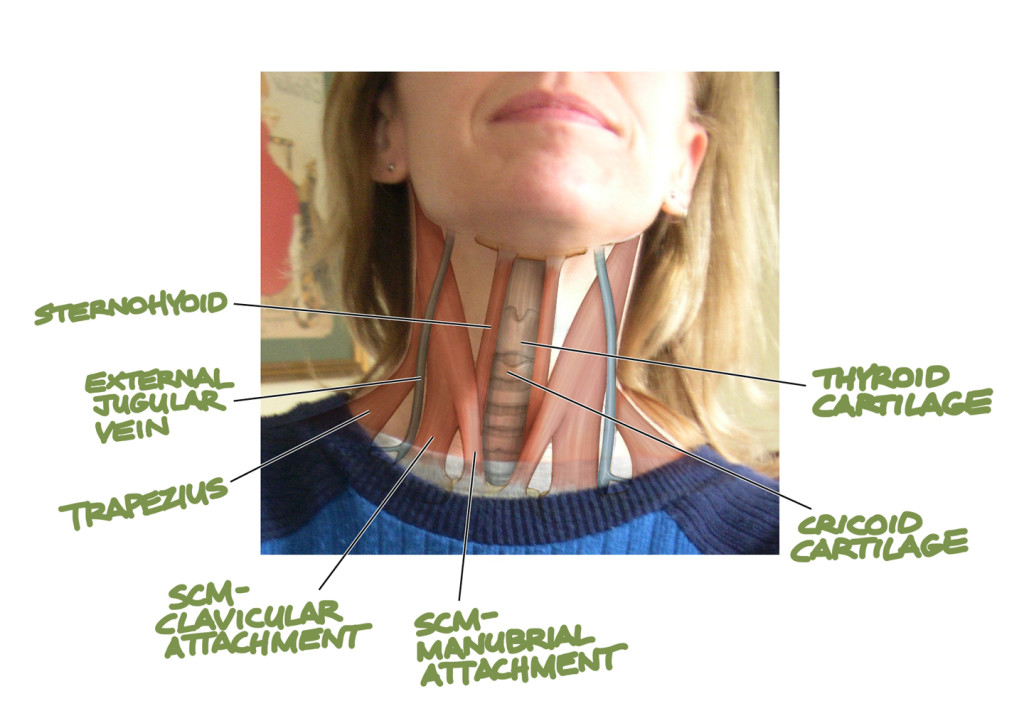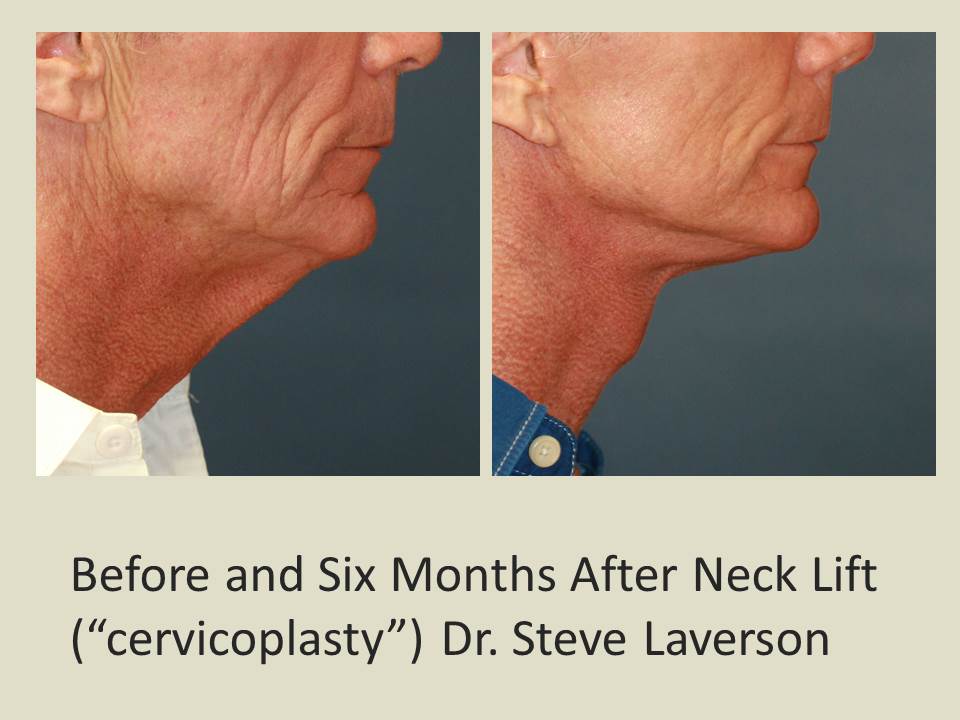INFORMED CONSENT for NECKLIFT (CERVICOPLASTY) SURGERY
INSTRUCTIONS
 This document contains information about neck lift surgery, associated risks, and alternative treatments. Please read each paragraph completely. If you have questions, need further information, or encounter words you don’t know, ask Dr. Laverson. Your signature at the end of this document confirms your knowledge and understanding of this information, and indicates your request for the necklift procedure.
This document contains information about neck lift surgery, associated risks, and alternative treatments. Please read each paragraph completely. If you have questions, need further information, or encounter words you don’t know, ask Dr. Laverson. Your signature at the end of this document confirms your knowledge and understanding of this information, and indicates your request for the necklift procedure.
INTRODUCTION
Necklift / cervicoplasty is a surgical procedure to improve the appearance of an aging, sagging, or unattractive neck. As individuals age, the skin and muscles of the neck region progressively lose tightness, and begin to sag. Fat may accumulate beneath the chin, contributing further to the appearance of fullness, aging, and loss of definition of the jaw. Necklift may produce lifelong results, but cannot stop the process of aging. Necklift improves the most visible signs of aging by tightening deeper structures, re-draping skin on the face and neck, and removing selected areas of fat. A necklift can be performed alone, or in conjunction with other procedures, such as a facelift, eyelid surgery, nasal surgery, or a chin implant.
Necklift surgery is customized for each patient. The procedure differs between individuals based on the contribution of fat, muscle, skin, and bony features to the aging or sagging appearance. Many younger patients are dissatisfied with features of the neck unrelated to aging, such as a fat or full silhouette lacking angularity and poor definition of the jawline.
ALTERNATIVE TREATMENT
Alternative treatments consist of no surgery for the appearance of the neck. Improvement of skin laxity, skin wrinkles and fat collections may be attempted by other treatments or surgery such as chemical peels, liposuction, clothing to conceal the neck, chin implant, or other measures. Risks and potential complications are associated with each of these alternative treatments.
RISKS of NECKLIFT SURGERY
Every surgical procedure involves some risk. If you are considering cervicoplasty, you should understand the risks and potential complications. Your choice to have the procedure is based on a comparison of the risks to the expected benefit. Although most patients do not experience the following complications, you should review them and ask Dr. Laverson any questions you have to make sure you understand possible problems which may arise.
Bleeding– It is possible, though unusual, that you may have problems with bleeding during or after surgery. Should post-operative bleeding occur, it may require emergency treatment to drain accumulated blood or require a blood transfusion. Do not take any aspirin or anti-inflammatory medications for ten days before surgery, as this contributes to a greater risk of bleeding. Non-prescription “herbs” and dietary supplements can increase the risk of surgical bleeding. Hypertension (high blood pressure) that is not under good medical control may cause bleeding during or after surgery. Accumulations of blood under the skin may delay healing and cause scarring.
Infection– Infection is unusual after this surgery. If an infection occurs, additional treatment including antibiotics or surgery may be necessary. If a chin implant is placed during the procedure and it becomes infected, surgical removeal of the implant may be necessary.
Scarring– Although good wound healing after necklift is expected, abnormal scars may develop on skin and within deeper tissues. Scars may be unattractive and of different color than the surrounding skin. Visible marks from sutures may result. Scarring may cause neck stiffness. Additional treatments may be needed to treat scarring.
 Damage to deeper structures– Deeper structures such as blood vessels, muscles, and particularly nerves may be damaged during the course of surgery. The potential for this to occur varies with the type of facelift procedure performed. Injury to deeper structures may be temporary or permanent.
Damage to deeper structures– Deeper structures such as blood vessels, muscles, and particularly nerves may be damaged during the course of surgery. The potential for this to occur varies with the type of facelift procedure performed. Injury to deeper structures may be temporary or permanent.
Asymmetry– The human neck is normally asymmetric (Right and left sides not exactly alike). There can be variation from one side to the other resulting from a neckift procedure.
Anesthesia– Both local and general anesthesia involve risk. Although complications are unusual, they can be unpredictable. There is a small possibility of injury and even death from anesthesia or sedation.
Nerve injury– Motor and sensory nerves may be injured during cervicoplasty. Weakness or loss of facial or lip movements may occur after neckift surgery (palsy). Nerve injuries may cause temporary or permanent loss of facial movements and feeling. Such injuries may improve over time, but the resulting deformity can be permanent and disabling. Injury to sensory nerves of the face, neck and ear regions may cause temporary or more rarely permanent numbness. Painful nerve scarring is very rare. Numbness of the neck may predispose to skin injury from shaving with a razor.
Swelling or Chronic pain– Swelling after necklift is totally normal, is not considered a complication, and takes many months to completely resolve. You will not see your result from necklift immediately. Swelling may cause visible irregularities, and obscure an underlying good developing result. Swelling may be localized to an area of drain placement for weeks after surgery. Chronic pain is a very rare complication after a necklift.
Skin disorders/skin cancer– A necklift is a surgical procedure for the tightening of skin and deeper structures of the neck. Skin disorders and skin cancer may occur independently of a necklift.
 Unsatisfactory result / Disappointing result – A poor and/or disappointing result from necklift surgery is possible. This includes risks such as unacceptable visible deformities, loss of neck movement, wound disruption, and loss of sensation. You may be disappointed with the results of surgery. Infrequently, it is necessary to perform additional surgery to improve your results.
Unsatisfactory result / Disappointing result – A poor and/or disappointing result from necklift surgery is possible. This includes risks such as unacceptable visible deformities, loss of neck movement, wound disruption, and loss of sensation. You may be disappointed with the results of surgery. Infrequently, it is necessary to perform additional surgery to improve your results.
Allergic reactions– In rare cases, local allergies to tape, suture material, or topical preparations have been reported. Systemic reactions which are more serious may occur to drugs used during surgery and prescription medicines. Allergic reactions may require additional treatment.
Hair loss– Hair loss may occur in areas of the neck where the skin was elevated during surgery. The occurrence of this is not predictable.
Delayed healing – Wound disruption or delayed wound healing is possible. Some areas of the neck may not heal normally or may take a long time to heal. Areas of skin may die. Frequent dressing changes or further surgery may be required to remove the non-healed tissue.
Smokers have a greater risk of skin loss and wound healing complications.
Long term effects– Subsequent alterations in facial appearance may occur as the result of aging, weight loss or gain, sun exposure, or other circumstances not related to necklift surgery. Necklift surgery does not arrest the aging process or produce permanent tightening of the face and neck. Future surgery or other treatments may be necessary to maintain the results of your necklift.
ADDITIONAL SURGERY NECESSARY
Many circumstances influence the long term result from necklift/cervicoplasty surgery. Even though complications occur infrequently, the risks described above are those particularly associated with necklift/cervicoplasty. Other complications can occur but are even less common. If complications occur, additional surgery or other treatments may be necessary. The practice of medicine and surgery is not an exact science. Although good results are expected, there is no guarantee or warranty expressed or implied with respect to the final results.
HEALTH INSURANCE
Health insurance excludes coverage for cosmetic surgery such as necklift/cervicoplasty and complications from surgery. Please review your health insurance contract for more information.
FINANCIAL RESPONSIBILITIES
The cost of surgery involves charges for several services provided. The total includes federal, state, and local taxes, licensing, regulatory mandates, fees charged by Dr. Laverson, the anesthesiologist, the surgery center, and any devices, implants, garments, or specialized equipment needed for the procedure. You are responsible for the total cost. If complications develop, additional unforeseen expenses may be incurred. You may be responsible for these as well. In the unfortunate (and unlikely) event this happens, Dr. Laverson tries to minimize additional expenses, but this may not be possible.
DISCLAIMER
This document communicates information about planned surgical treatment and discloses risks and alternative treatment(s). The informed consent process attempts to define principles of risk disclosure that should meet the needs of most patients in most circumstances.
This document is not all inclusive in defining other methods of care and risks of the procedure. Dr. Laverson may provide you with additional or different information which is based on all the facts in your particular case and the state of medical knowledge.
Informed consent documents are not intended to define or serve as the standard of medical care. Standards of medical care are determined on the basis of all of the facts involved in an individual case and are subject to change as scientific knowledge and technology advance and as practice patterns evolve.
Understand the above information completely before signing the consent below.
CONSENT FOR NECK LIFT / CERVICOPLASTY SURGERY
1. I have read and understand the above information about neck lift surgery, and request that Dr. Steve Laverson and assistant(s) perform NECKLIFT SURGERY upon me.
2. Rarely, during the course of an operation and anesthesia, unforeseen conditions may demand additional or different procedures than those above. Dr. Laverson is authorized to perform such other procedures that are in his professional judgment necessary and desirable and in my own best interest. The authority granted under this paragraph shall include conditions that require treatment and are not known at the beginning of the procedure.
3. I consent to the administration of such anesthetics considered necessary or advisable. Although generally safe, all forms of anesthesia involve a small risk and the possibility of complications, injury, and rarely, death.
4. No guarantee or warranty is expressed or implied regarding the final result of the procedure.
5. I consent to the disposal of any tissue, medical devices or body parts which may be removed.
6. IT HAS BEEN EXPLAINED TO ME IN A WAY THAT I UNDERSTAND:
a. DETAILS OF THE NECK LIFT PROCEDURE
b. ALTERNATIVES TO NECK LIFT SURGERY
c. RISKS AND POSSIBLE COMPLICATIONS OF NECK LIFT SURGERY
I CONSENT TO NECK LIFT SURGERY AND THE ABOVE ITEMS (1-6). I AM SATISFIED WITH THE EXPLANATION.
_____________________________________________________________________
Patient or Person Authorized to Sign for Patient
Date________________________ ___________________________________Witness

 Book Now
Book Now









